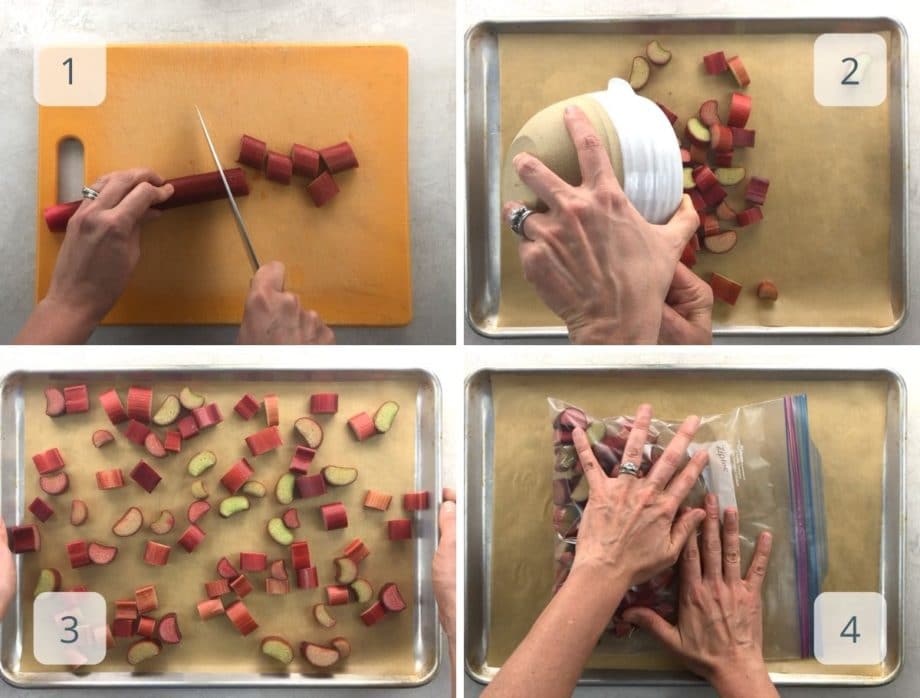Rhubarb comes in hot for a short season, which is why it's a prime candidate for freezing. Luckily, it's quick and easy to do. Here's how to freeze rhubarb and enjoy it all year long.

Can you freeze rhubarb?
If you're swimming in produce from your garden, farmers' market, or CSA, you may be wondering:
- Can you freeze rhubarb?
- Okay, but does it freeze WELL?
- In what kinds of recipes can you use it?
Great news, friends. Rhubarb is a prime candidate for freezing. It's easy to freeze, it holds up great in the freezer, and you can use it in virtually all cooked recipes that call for fresh.
Here's how to do it.
How to do it
It only takes five minutes to prep this veggie for the freezer. Here's what you'll do.

- Prep the stalks. Remove any leaves (which are poisonous) and wash and dry the stalks well. Trim and discard the ends. Then slice the stalks into segments. Half to one inch is a great all-purpose size. Or prep according to specific recipes if you know what you'll be making.
- Line a rimmed half-sheet pan with parchment.
- Spread the pieces evenly over the prepped pan, without crowding. One pound fits perfectly on a half-sheet pan. Freeze until solid, about 24 hours.
- Transfer the frozen segments to a sealable freezer bag or reusable container. Keep frozen for up to a year to use in your favorite recipes.
Expert tips and FAQs
You can easily keep it for up to a year, after which you'll have a whole new crop.
The great news here is that you can use frozen rhubarb in virtually any recipe that calls for fresh (as long as there's cooking or baking involved). See the section below for our favorite ways to use it.
Blanching is boiling very briefly and then plunging into cold water. You really do not have to blanch this vegetable before freezing.
You sure can. Just wash, dry, and cut into segments as detailed in the post for ease of use.
When using it in cooked recipes, we find that frozen is just as good as fresh. Like most fruits and veggies, this one gets very soft when thawed, but you can add it to recipes without thawing it first. You may need to add a few minutes to the cooking or baking time, depending on the recipe, but should not need to make any other changes.
Nope, you don't have to! And in fact we don't recommend it. It gets soft when thawed, so it's easier to work with frozen.
Yes, you can! If you'd rather not freeze it raw, you can also make our sauce/compote and freeze that.
How to use it
The great news is that you can use it in pretty much any recipe that you'd use fresh. Here are our favorites:

Hungry for more?
Subscribe to Umami Girl's email updates, and follow along on Instagram.

How to Freeze Rhubarb
Ingredients
- 1 pound rhubarb stalks
Instructions
- Wash rhubarb well. Remove and discard any leaves.
- Trim and discard the ends from the rhubarb stalks.
- Slice stalks into segments of about ½- to 1 inch.
- Line a rimmed baking sheet with parchment and distribute the rhubarb on the baking sheet, without crowding.
- Freeze until solid, about 24 hours.
- Place frozen rhubarb into a zip-top freezer bag or other tightly sealed container.
- Keep frozen for up to a year to use in all your favorite rhubarb recipes.
Video
Notes
- If you know which recipes you'll be using the rhubarb in, you can cut the stalks to the size specified in the recipes. Otherwise, ½- to 1-inch segments are pretty much all-purpose.
- Here's where to get a rimmed baking sheet and precut parchment to fit a half-sheet pan.
Nutrition
Hungry for more?
Subscribe to Umami Girl's email updates, and follow along on Instagram.








Leave a Reply